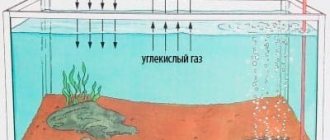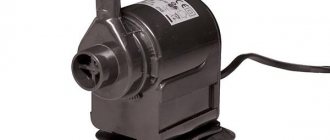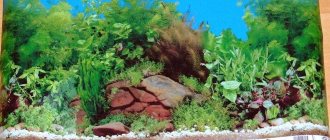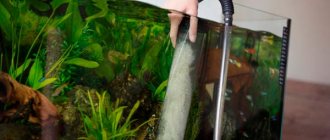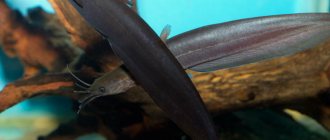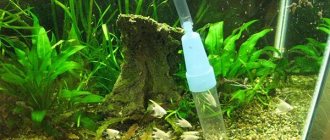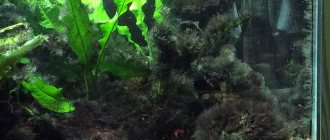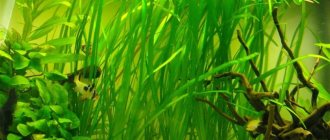Decorating an aquarium with your own hands is not at all difficult. There are many possibilities for arranging a home for fish. It is enough just to adhere to the strict but simple requirements that fragile small organisms require.
In this article we will look at the features of aquarium arrangement, rules and design styles. Let's find out about the available decorations for vessels. Let's consider the procedure for decorating a home pond.
Features of aquarium arrangement
Aquariums are one of the most popular hobbies of the world's population. She knows no boundaries, boundaries and national hatred. Exhibitions are held annually to showcase new fashion trends. They are created by aquarium designers who have received worldwide recognition.
The aquarium itself is a complex closed ecosystem.
Features of the arrangement of a particular reservoir depend on the following factors:
- What is the purpose of the aquarium? It can be decorative, species, spawning.
- Where it will be located: apartment, office, exhibition center and so on.
- Freshwater or marine.
- What kind of fish and plants do you plan to populate the vessel with?
- A lot depends on the shape and size of the jar. They are rectangular, square, corner, round.
Rules for designing an aquarium
There are general rules for arranging an artificial reservoir.
When creating aquadesign, you should strictly adhere to the following steps:
- It is necessary to decide on the fish that will populate the reservoir.
- Select plants, shellfish and aquaculture for them.
- Select soil.
- Decide on the size and shape of the vessel.
- Select and install equipment.
- Decor.
- Launch.
Cover glass
You can purchase a cover glass for your aquarium. Very often it comes either complete with an aquarium, or its role is played by a plastic cover with a built-in lamp and a small hole for feeding fish. Despite the fact that the second option looks more pleasant, the lamp included in the kit is often quite weak. Replacing it with a more powerful one is usually not possible. Therefore, the built-in lamp will not allow you to grow those plants that require a lot of light. That is, perhaps over time the aquarium lid will be removed to the loggia or mezzanine.
The cover glass allows light to pass through and allows you to install any light fixture you like. The most difficult thing here is to choose the size and shape of the glass so that it does not interfere with the mounting of aquarium equipment, including the lamp.
A cover glass reduces the rate of water evaporation, covers the aquarium from dust, and also prevents some aquarium inhabitants from escaping.
Which style to choose (what determines the choice)
Choosing a design style for a pond is one of the most difficult tasks. Large companies even resort to the services of aquatic designers.
But usually they proceed from the purpose for which the reservoir will serve, and the choice is made on which inhabitants. Also, a lot depends on the availability of decorative materials. Is it possible to purchase them or make them yourself?
Much also depends on the capabilities of technical equipment, fertilizers, and water additives.
For example, experienced hobbyist aquarists often choose very labor-intensive Dutch aquariums. They allow you to demonstrate the luxury of the underwater world and create a collection of plants. And the elegant Japanese style is incredibly popular at various competitions.
Aquarium styles
There are a number of styles that have gained wide popularity. Therefore, there is no need to invent anything; it is enough to turn to ready-made options. Let's take a closer look at them.
Dutch
These luxurious reservoirs began to appear in Russia in the 90s. Since then, their popularity has not waned.
The Dutch Aquarium is an underwater garden with a carefully selected variety of plants. Sometimes they have terraces. Here you can see inhabitants from all continents and all the colors of the rainbow.
The fish are also selected based on the principle of brightness and contrast, living in different layers of water. The main thing is that animals must be peace-loving, easy-going, not spoil plants, and prefer one temperature regime so that everyone is comfortable.
These are very labor-intensive ecosystems that require a lot of experience, knowledge and investment of money.
Collector's
One of the varieties of underwater garden. Requires volumes of 50 liters. The principle is as follows: available types of aquatic plants are used (from 15 species), which are planted at the discretion of the author. Over time, they grow, penetrating each other's territory. It gives the impression of a neglected garden. To revitalize the landscape, tall and low-growing types of vegetation are combined.
This type is considered universal. It easily fits into the design of any room.
Pseudo-natural 3D landscapes
This style imitates rivers, mountains, forests, gorges, and architectural forms. To create similar landscapes under water, artificial decorations are used. Some experts even manage to create waterfalls underwater. This is done using special equipment and white sand.
Japanese
For lovers of minimalism. Quite modest, but at the same time laconic and expressive underwater landscapes. Soil, sand, a few stones, an elegant school of small fish. The main difference is that three or four stones are used to create this design. Main (largest), two medium and one small (sacrificial).
When creating, they use models of stones for special Japanese compositions.
Natural
This is a piece of the world that was spied on from nature and transferred to an aquarium. Thus, a forest path under water, a thick windfall, and a clearing with flowers are created. Plants are planted very densely. Maintaining the life of such an aquarium requires the use of sophisticated technologies.
Is real art. Recognized master - Takashi Amano.
Disney
They are copies of scenes from popular cartoons about Nemo and the Little Mermaid. Children's rooms are decorated with similar aquariums.
Landscapes are decorated with treasures, grottoes, plants, corals and castles made of synthetic materials. Fish and plants are selected as bright as possible. Shells are exotic and intricate.
Pseudo-sea
It differs from sea water in that instead of sea water, fresh water is poured into it; accordingly, it is populated by freshwater inhabitants.
There are special techniques to achieve the illusion of a real seascape. They come in warm tropical styles and cool tones.
When decorating, coral decorations are used, and they are populated with bright African cichlids.
Aquarium filtration system
Fish in an aquarium need proper care. They cannot exist in dirty water, this leads to illness and death. The owner will have to regularly change the water in the aquarium and clean the walls. But even such care cannot provide fish with adequate conditions for a healthy life. A special filtration compressor will help solve this problem.
Which filter is better
Compressors that filter water in an aquarium come in two types: external and internal.
External compressors are recommended for installation in large aquariums. They are impressive in size and look like a canister, inside of which there are several filter media and tubes. They work efficiently, but are quite noisy, so it is not recommended to install an aquarium with such a compressor in the bedroom.
Internal filtration compressors are more economical, have compact dimensions, and create a low noise level during operation. This system is a small plastic container, inside of which there is a ceramic filler and a pump that pumps water. Such a unit can be installed in an aquarium with a volume of 20 to 200 liters. In large tanks it is used as an additional filter.
Design options
You can choose the design option for the aquarium yourself, focusing on beautiful pictures on the Internet. Although you can simply pour soil, plant plants and introduce unpretentious fish.
More complex options will require special tools and skills. Snags require long and complex processing. And terraces without fastening will creep away under the influence of plant roots and the activity of fish and shellfish.
Let's look at the most popular options for do-it-yourself aquarium design.
Aquascaping 50 l
When they talk about aquascaping, they mean a special new technique for placing plants, driftwood and stones. Thanks to it, the underwater world has the appearance of a garden or landscape. This is an art that obeys certain rules and requires the use of complex technologies.
There is even a line of business specializing in products for aquascapers.
Complete aquascaping kits are sold for 50 liter aquariums. You can just take a vessel, the rest can be purchased according to the specialist’s taste.
Typically the sets are:
- aquarium;
- external hanging filter;
- lamp;
- cover glass;
- thermal insulation substrate;
- thermometer;
- ground dressing;
- priming;
- complete complex fertilizer;
- main food for shrimp.
Aquarists select plants themselves. Preference is given to slowly growing species. Landscapes that create the complete illusion of any area are considered ideal. Since the volume is small, the biological balance in it is very fragile and unstable. Therefore, filling with fish is kept to a minimum.
Aquarium 100 l
A 100 liter aquarium gives you more possibilities. You can use the Japanese style to create amazing rocky terrain.
Small plants are planted in the foreground, while larger species occupy the background.
The main thing is to avoid symmetry and place a bright detail in the center. For example, a snag, a rock or a waterfall.
Capacity 200 l
The greatest scope for imagination is provided by aquariums from 200 liters. Here you can create a huge park with amazing plants and colorful fish. However, it must be borne in mind that the Dutch aquarium is very demanding in terms of care.
A large vessel is perfect for a pseudo-marine aquarium. The thing is that many cichlids live best among artificial and well-fixed decorations. These large, bright and attractive fish have a bad habit of destroying living plants and moving stones.
Decoration of an aquarium. Where to begin?
First of all, you need to imagine what the finished pseudo-sea aquarium will look like: what decorative elements are worth purchasing, soil material, background color, fish species, arrangement of the aquarium. Once an accurate picture of the future aqua world emerges in your head (or on paper), you can begin to implement it.
To design an aquarium in the pseudo-sea style, you will need a large capacity - at least 150 liters.
Shape and volume of the aquarium
To design this style, you will need a large container - at least 150 liters. It will solve two problems at once - no fights between fish, and more space to bring your dream aquarium design to life. The optimal height of the walls for a pseudo-sea is 50 cm. In low aquariums it is easier to build coral reefs and slides.
The shape of the container for this style can be any - standard rectangle, delta, ball.
Priming
The ideal option would be marble or coral chips, which resemble coarse sea sand. For every 10 liters of aquarium volume, 1.5 kg of soil is poured.
Plants and decor
The main elements of the pseudo-sea are corals and sea shells.
Since you can't use live corals, synthetic substitutes will do the job. Stones of non-standard shapes and sizes will be an excellent decoration. You should choose shell rock, sandstone and limestone. Before putting them in water, you should carefully inspect the surface for rust, cracks and crevices. The stones are then washed with running water and boiled for 15 minutes.
You can add driftwood to the pseudo-sea aquarium design. It should be remembered that some types of trees are not suitable for keeping in aquariums because they contain acids. These do not include only mangroves and cork trees.
If the snag has colored the water an amber color, you can add activated carbon tablets to the filter. It will not only cleanse the color, but also eliminate harmful impurities.
The main elements of the pseudo-sea are corals and sea shells. Since you can't use live corals, synthetic substitutes will do the job. They are environmentally friendly, durable and will not harm either the fish or the walls of the container. You can also prepare real corals by first boiling them and rinsing them in water. Sea shells should not be boiled. This will cause them to lose their pearly shine. It is enough to pour boiling water over them several times.
The pseudosea aquarium must have enough free space. Make sure that stones and other heavy decorations press evenly on the soil and base of the container. The pseudo-sea style does not provide for planting living plants, but they can be replaced with plastic ones.
You can add driftwood to the pseudo-sea aquarium design. It should be remembered that not all types of trees are suitable for keeping in aquariums.
Caring for real decorative elements is complex and regular. In addition, over time, water will begin to leach calcium from the shells, making the environment hard. Not every fish will be able to withstand it. Therefore, when creating a pseudo-sea, it is recommended to use artificial decor. It can be boiled and washed countless times, and the color will remain the same bright for a long time.
Pseudo-sea inhabitants
In most cases, Malawi cichlids, dolphins, zebras, red parrots, Lombardos, Melanchromis maigano and other bright and unusual species become the inhabitants of the pseudo-sea. You can add snails, shrimp or catfish, which will clear the walls of the aquarium from thickets.
The number of fish in the pseudo-sea is determined at the rate of 1 individual per 7-10 liters of water. You should not overpopulate the cichlid fish so that the fish feel comfortable in their “new home”.
In most cases, cichlids become residents of the pseudo-sea
Equipment
Be sure to have a powerful filter and compressor. The absence of flora will increase the load on the biobalance of the aquaworld, so a more powerful unit is needed. A sterilizer and thermostat will also be a useful purchase. To tint the water an azure blue and highlight the fish and scenery, you will need fluorescent lamps in cool shades. Since there is no vegetation in the water, the duration of daylight hours should be no more than 4 hours.
Twice a month you need to clean the soil from fish waste and change a quarter of the water volume. Once every few months, you need to wash plastic plants and corals from plaque.
How to decorate
Nowadays there are many possibilities for decorating an aquarium. Even the soil has turned into a decorative detail. However, let's consider everything in order.
Priming
You can prepare the soil for the aquarium yourself. Collect from the nearest area where there is suitable sand or beach and then sift using a sieve. Or you can buy it in one of the stores.
When selecting and purchasing, you must take into account that nutritious soils are on sale. They contain substances that enhance plant growth and give them a more impressive and healthy appearance. And there are decorative ones that are not suitable for plants.
Soils are made from the following materials:
- quartz;
- pebbles;
- sand;
- gravel;
- coral sand;
- artificial (plastic, glass, polymers).
In addition, soil particles differ in color (black, white, colored) and size.
For planting plants in decorative soils, a special nutrient litter is used.
Stones for decoration
Stones are considered the simplest and cheapest natural material. They are spectacular and are used as natural grottoes. However, not all selected cobblestones are suitable for decorating an aquarium with stones.
Hobbyists and experts select the following types of decorative elements:
- volcanic origin;
- marble, granite and their varieties;
- sea and river pebbles.
You don’t have to go to exotic countries to find volcanic stone. They have been successfully supplied to pet stores for a long time.
Also suitable:
- quartzite;
- amber;
- slate;
- porphyry;
- gneiss.
To decorate an aquarium with stones, it is not necessary to collect heavy cobblestones. There are light synthetic options. Fashionable are light ones, hanging in the water column, decorated with mosses and ferns. They are attached to the bottom and walls on a transparent fishing line of the required length.
driftwood
You can choose driftwood in the forest and prepare it yourself. The literature contains a description of how to select, boil and prepare driftwood for an aquarium. This is a very popular decorative element that adds some zest to the seascape. Some fish enjoy grinding down snags, adding variety to their diet.
But you can also buy it. The most popular is mangrove. This tree is popular because it does not rot, does not float, and has a beautiful structure and color. Harmless to fish.
Vegetation
Plants can be natural or artificial. If an aquarist prefers live plants, then he will have to master the secrets of growing, propagating and pruning them. Hobbyists, knowing the characteristics of their pets, create entire semi-flooded gardens.
But artificial vegetation is no worse and less capricious. It is better to give preference to well-established companies. They will last longer, look natural, and are harmless to animals.
For better plant growth, special fertilizers are used, which are added to the water and do not oppress the other inhabitants of the reservoir.
Back wall (background)
A decorative background creates the background of the aquarium. With a well-calculated design, the middle ground smoothly flows into the background, creates perspective and details the landscape.
The decorative background can be:
- Film glued to the outside of the back wall. The plots are very diverse. From underwater gardens to animated stories.
- Cork tiles.
- Plastic imitations.
- Volumetric backgrounds. They are attached from the inside of the vessel. But over time, they can pose a danger to fry, small fish and animals. The background peels off from the base, the animals get inside, cannot get out on their own and die. In addition, cheap plastic can release harmful substances into the water.
Other types of decor
In addition to the decorative elements described above, there are many more options.
Available for sale:
- Grottoes: barrels, flowerpots, vases, decorations-shelters with moss, minks, pots.
- Castles, fortresses, ships, anchors, artificial driftwood.
- Figurines: stars, octopuses, jellyfish, volcanoes, mushrooms, figurines.
To make your own decor, you can use regular foam.
Scheme of working with it:
- A castle, rock, stone is cut out of a piece of foam plastic.
- The front side is fired until small bubbles appear.
- While the surface is hot, cement, alabaster or gypsum is applied to it.
- Wait until the surface is completely dry and paint it with gold or gray paint.
- Attaches the front side to the aquarium.
Making “treasuries” from pebbles.
These interesting interior details can be made from ordinary pebbles picked up on the beach:
- Small stones of round shape and the same size are selected.
- The required drawing is selected in advance.
- The pebbles are glued together according to the pattern using silicone glue.
This is how caves, bridges, castles and fortresses are created. If it’s difficult to come up with the shape of an object yourself, then on the Internet you can always find an example of work and a step-by-step execution scheme. Glass beads are suitable for decoration. Some craftsmen even manage to make decorative pearls.
The procedure for decorating an aquarium
Before decorating an aquarium, you need to carefully consider the decor and purchase the necessary materials. Only after this can we begin to create a unique corner of the water world.
Let's look at the order of the design work:
- Soil is placed on the bottom of the vessel using a special plastic spatula. Usually it is placed in several layers: sand, followed by gravel of large and medium fractions.
- Bacterial cultures for plants are scattered. This is a special nutritional layer.
- Places where large, heavy objects are planned must be lined with foam plastic.
- The background is created. An external film is pasted or artificial decorations are installed.
- Interior design. Stones are laid out, driftwood and decorations are installed. Plants are being planted.
- Filling with water. To prevent the stream of water from eroding the soil and spoiling the aquarium design, it is recommended to place a flat plate under it.
- During the first two days, the operation of the equipment and the integrity of the container are checked.
- The first inhabitants appear: snails and shrimp.
- Within a week or two, biological equilibrium is established. The water becomes cloudy, then becomes clear.
- You can release fish.
Useful tips
To make their work easier, beginners should pay attention to a number of useful tips from experienced specialists. They are simple, but will help you avoid many troubles both at the initial stages and in the future.
When choosing, filling and decorating an aquarium, you should consider:
- If you have a small room, then a square aquarium is best. It can be placed in a corner or even in the middle of the room.
- Living room. A designer pond with a view is best suited for it. There are options without fish, exclusively with decorative elements.
- The ecosystem of large vessels is more stable than small ones.
- When cleaning the aquarium, no chemicals are used. The best is warm water with vinegar.
- Instead of a soil scoop, you can use a cut plastic bottle.
- Sometimes interesting objects are fixed on the walls or bottom. Silicone glue is used for this.
- The soil is laid out with a slight slope. To prevent it from moving, it is recommended to strengthen it with plastic terraces or stones.
- You should not use natural shells for decoration. Due to the large amount of calcium released into the water, they change its composition and hardness.
- Choose aquarium decorations made from safe materials.
- It is prohibited to make decorations from alkaline materials. They change the chemical composition of water. They make it unsuitable for fish.
- When choosing stones, avoid sharp edges. They can cause injury to fish.
- A round jar does not need a background.
- To lay the soil in colored stripes, simply insert cardboard sheets between them as limiters, and then pull them out.
- It is important to choose the right plants. Sometimes a few inexpensive popular species will be enough to fill the water space in an original way.
- Some plants with a strong root system are best planted in pots or clay containers filled with nutrient soil. In the future, the decoration will not deteriorate, and the plant can be easily removed and rearranged.
- To make the fish look brighter, a dark shade of soil is recommended.
- Oak driftwood is not recommended; this wood stains the water.
- Before placing in a pond, stones and shells collected with your own hands must be boiled for 5-10 minutes for disinfection.
- Individual parts of the aquarium, as well as plants such as moss, are secured with transparent fishing line or clamps.
- You need to select the fish you would like to purchase in advance. Find out everything about the features of their content. Focus only on species that get along together and have similar conditions of detention.
- After purchasing the fish, you must quarantine them for a week in a separate aquarium. This is done in order not to introduce infection into it and not to destroy the remaining inhabitants.
- Figurines, amphorae, monuments and castles placed in an aquarium require regular cleaning.
- Water parameters should be constantly measured and maintained.
- When selecting an aquarium and designing it, you should definitely take into account ease of maintenance. We must remember that cleaning, cleaning, and changing water can take a lot of time. Otherwise, the reservoir risks turning into a swamp.
Special requirements when decorating a 100 liter aquarium
When creating an aquarium, everyone wants it to not only provide a haven for fish and other creatures, but also to look beautiful. For this reason, it is worth placing some decorations in it. They will not only be an elegant addition, but also a hiding place for fish. When choosing decorations for your aquarium, however, be very careful. By placing inappropriate items in the water, you can change its PH and cause fish poisoning. To avoid this, it is worth familiarizing yourself in detail with the features of a particular piece of equipment.
Important! When choosing aquarium decorations, always make sure that they are suitable for the specific type of fish!
Aquariums contain different types of decorations, both natural ones, such as roots, rocks or plants, and artificial ones, such as castles or caves. However, it is worth remembering that not all of these decorations are suitable for every type of fish. For example, rocks change the hardness of the water, and placing roots in an aquarium can lead to algae development. Most decorations can change the pH of the water. In addition, it should be remembered that sea turtles have completely different requirements than fish regarding aquarium decor.
You need to be vigilant when purchasing artificial jewelry. Not every castle that looks nice can be safely placed in an aquarium. First of all, you should never put any artificial figures (such as toys) into the aquarium that are not intended for that purpose. This may cause fish poisoning.
